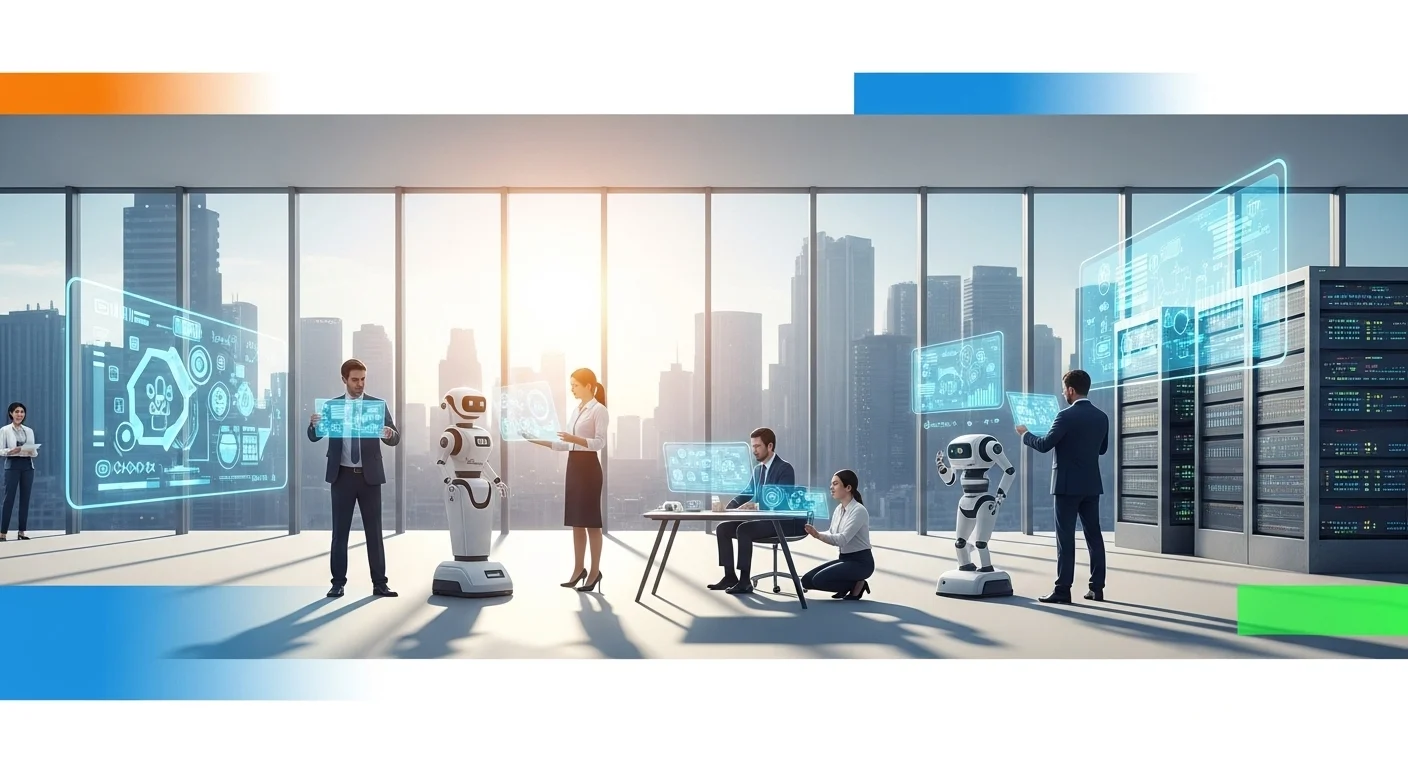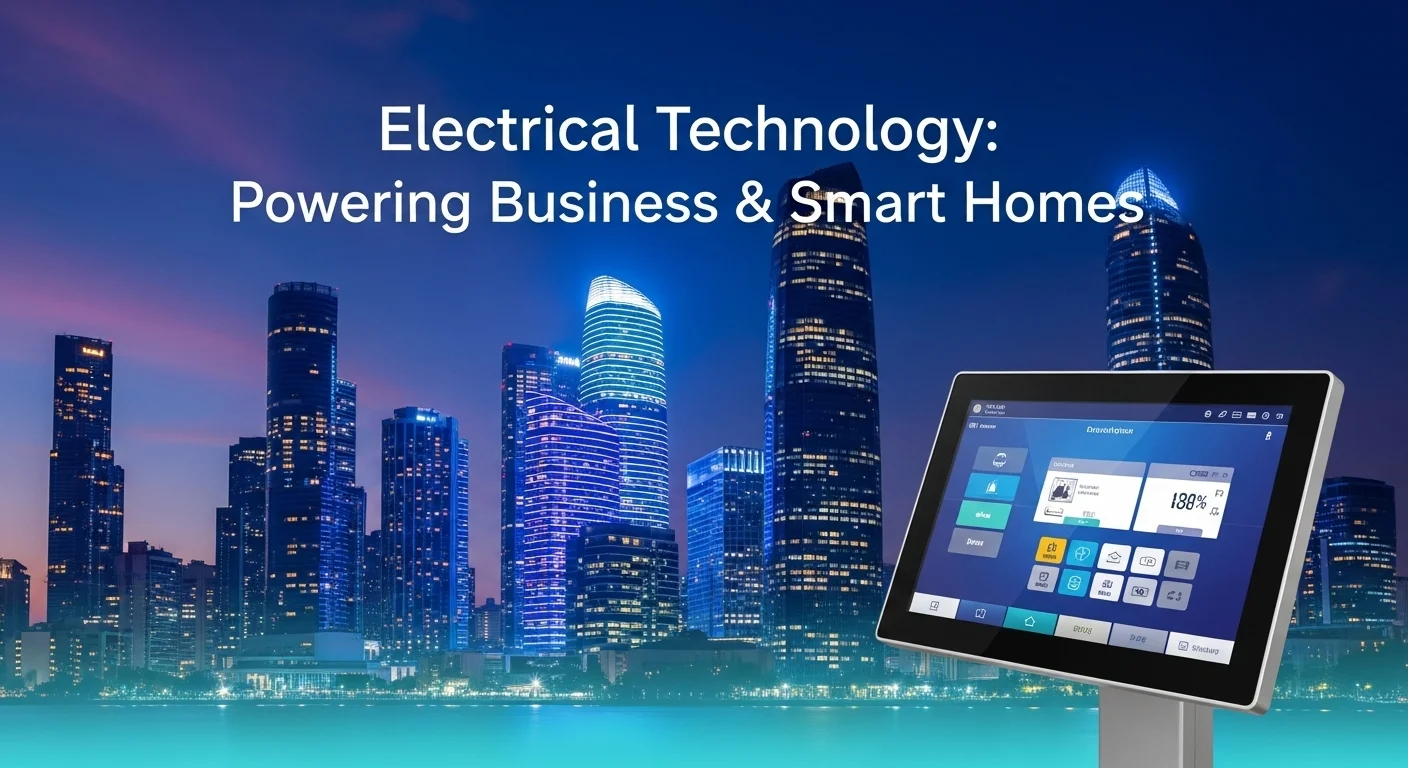Your Guide to Electrical Technology: Building a Smarter, More Secure World

Executive Summary
After two decades in this field, I've seen electrical technology evolve from simple wiring into the very nervous system of our modern world. It’s the invisible magic that powers everything from the industries that build our economy to the smart assistant in your kitchen. In this article, I'm going to pull back the curtain on this fascinating world. We'll explore how digital transformation is changing businesses through automation and smart energy use. We'll spend a good amount of time on a topic I'm passionate about: the smart home. I'll walk you through what a smart electrical system really is and what you should look for to build the best one for your family. And crucially, we'll tackle the growing challenge of cybersecurity, looking at how leaders like Schneider Electric are working to protect the critical systems we all rely on. Whether you're a business leader or a tech enthusiast, my goal is to give you the insights you need to harness this technology for a more efficient, secure, and innovative future.
Table of Contents
What is Electrical Technology and Why is it So Important?
Let’s start with a simple truth: electrical technology is the lifeblood of modern society. It’s the applied science of managing electrical energy—creating it, moving it, storing it, and using it. Without it, the entire digital world, from AI to the device you're reading this on, would be nothing more than a fantasy. Every single server, processor, and sensor is completely dependent on a controlled, reliable flow of electrons. I’ve always found it amazing that this invisible force animates everything we do. On a massive scale, it’s the national power grids that fuel entire economies. On a tiny scale, it’s the microscopic circuits processing information at the speed of light. For any business, a stable electrical supply isn't just a utility bill; it's a core strategic asset. I’ve seen firsthand how a power disruption can bring a company to its knees, causing huge financial and reputational damage. As businesses embrace digital transformation with automation and robotics, their hunger for not just power, but *intelligent* power, grows exponentially. This is where electrical technology has become so exciting, offering solutions that don't just supply energy but also monitor, control, and optimize its use, saving money and helping the planet.
The applications today are truly mind-boggling. In manufacturing, I’ve seen smart factories where electrical systems are woven into IoT platforms. This allows for things like predictive maintenance, where an AI can analyze electrical signatures to flag a machine for repair *before* it breaks down, preventing costly downtime. A field called power electronics has given us incredible tools like variable frequency drives (VFDs), which fine-tune motor speeds to slash energy use in heavy machinery. For commercial buildings, these advanced electrical systems are the heart of automation, managing everything from lighting and HVAC to security, creating spaces that are both comfortable and incredibly efficient. They can even learn occupancy patterns to adjust energy on the fly. And of course, the boom in renewable energy from solar and wind is entirely driven by innovations in electrical technology. Inverters, grid-tie systems, and energy storage are the key pieces of the puzzle that allow us to integrate clean energy into our power grid, a critical step in addressing climate change. We're moving from a one-way, centralized power model to a smarter, distributed grid, and it's all thanks to these advancements.
The Smart Home Revolution
Of all the applications, the one that gets people most excited is the smart home. The idea of a connected, automated living space has gone from a sci-fi dream to a daily reality for millions. At the core of this revolution is the smart home electrical system. This isn't just about wires and outlets anymore. It's a sophisticated network that integrates lights, thermostats, locks, and appliances into a single, intelligent system. This is what home automation electrical systems are all about—letting devices talk to each other and respond to your needs, whether you use a voice command, a phone app, or a pre-set schedule. It's about creating a home that isn't just powered, but is responsive and intuitive. The benefits are obvious: convenience, better security, and real energy savings. Think about your lights turning on as you pull into the driveway, the temperature adjusting automatically for you, and the doors locking themselves at night. It's a real upgrade to your quality of life.
When people ask me about installing a smart home electrical system, they always want to know what the best smart home electrical system is. The truth is, the 'best' system is the one that fits your life. It comes down to a few key things: reliability, compatibility, scalability, and ease of use. It absolutely has to be reliable; nobody wants a smart light that doesn't turn on. Compatibility is huge because you'll be buying devices from many different brands that use various protocols like Wi-Fi, Zigbee, and Z-Wave. A great system acts as a universal translator for all of them. Scalability is also important—you want a system that can grow with you as you add more devices over the years. And finally, it has to be simple to use. A clean, intuitive app is what makes all that complex technology accessible. From an electrician's standpoint, the underlying electrical technology needs to be right. This often means ensuring you have neutral wires for smart switches or dedicated circuits for power-hungry devices like EV chargers to make sure everything runs safely and smoothly.
Cybersecurity: The New Frontier in Electrical Systems
As we connect more of our electrical systems, we also open them up to new dangers. Cybersecurity has become one of the most critical issues in my field, not just for smart homes, but especially for the industrial and infrastructure sectors. The very connectivity that gives us remote control and monitoring can also be a backdoor for hackers looking to cause chaos. A cyberattack on a power grid or a water treatment plant isn't a Hollywood plot; it's a real-world threat with devastating potential. This has forced the industry to make cybersecurity a non-negotiable part of modern electrical technology. Companies in this space have had to become experts in both power engineering and digital defense, building systems with multiple layers of protection against an ever-changing landscape of threats.
A company that I've seen take this extremely seriously is Schneider Electric. They understand the immense risks involved, and have made schneider electric cyber security a central part of their entire philosophy. They develop solutions for critical infrastructure that build robust security measures right into the control systems from the ground up. This 'security by design' approach is vital for protecting what we call Operational Technology (OT) environments—the systems that control physical processes. Their EcoStruxure platform, for instance, is a powerful IoT-enabled architecture that not only provides automation but is also fortified with cybersecurity features like network segmentation, strict access controls, and constant threat monitoring. By partnering with leading cybersecurity firms, they’ve also bolstered their ability to help customers spot vulnerabilities and respond to threats in real-time. This intense focus on schneider electric cyber security really drives home a modern truth: the reliability of our electrical world is now completely intertwined with its digital security. The future of electrical technology, from the biggest power plants to the simplest home automation electrical setup, depends on building systems that are not only smart, but also secure.

Getting Under the Hood: The Tech and Business of Electrical Systems
When you dive deeper into electrical technology, you find a fascinating world where physics, engineering, and business strategy collide. For any company trying to stay competitive, understanding these electrical foundations is absolutely crucial. On the technical side, you have disciplines like power electronics, which is all about efficiently converting and controlling electricity. This is the magic behind the power supplies in our gadgets, the inverters for solar panels, and the motor drives that have transformed factories. Being able to precisely manage power allows businesses to cut waste, improve their processes, and build more reliable products. Then there's control systems engineering, which uses sensors and feedback to manage complex systems. In our world, that means everything from keeping the national power grid stable to ensuring a robotic arm moves with pinpoint accuracy. Now, we're seeing these fields supercharged by Artificial Intelligence (AI) and Machine Learning. I’ve worked on projects where AI algorithms optimize a building's energy use in real-time or predict when a critical piece of electrical equipment needs maintenance, saving millions in potential downtime. This blend of classic electrical engineering and modern data science is unlocking incredible new levels of performance.
From a business standpoint, these technical capabilities translate into powerful strategies for growth. Energy Management Systems (EMS) are a perfect example. An EMS combines smart meters and sensors with powerful software to give a company a crystal-clear view of its energy consumption. By analyzing this data, businesses can pinpoint waste, launch targeted efficiency programs, and track their progress. This doesn't just cut costs; it builds a great reputation in a world that cares about sustainability. Another smart business move is adopting predictive maintenance for electrical gear. Instead of just replacing parts on a fixed schedule, this approach uses real-time data to assess the health of transformers and machinery. For industries where failure means a full production stop, this shift from being reactive to proactive is a game-changer for both the bottom line and worker safety. Even the initial design of an electrical system has become a strategic business decision. When a company builds a new data center, choices about power distribution, backup systems, and cooling will impact their operating costs and reliability for decades. Making those choices with expert guidance in electrical technology is no longer just an IT issue; it’s a critical business function.
How to Build the Best Smart Home Electrical System
Embarking on the journey to a truly smart home is an exciting process, but it requires some planning to get it right. My goal is always to help people build the best smart home electrical system for their lifestyle—one that feels intuitive and just works. The foundation is always a mix of solid wiring and smart communication. While many devices are wireless, I’ve found that the most reliable setups have a hardwired backbone, especially for things like your central hub or streaming devices. This is where structured wiring comes in, running a bundle of data and video cables to key spots in the house. It's a bit of future-proofing that ensures your home is ready for whatever comes next. For the home automation electrical components, one of the biggest decisions you'll make is the communication protocol. Wi-Fi is everywhere, but it can get crowded. Technologies like Zigbee and Z-Wave are mesh networks designed for home automation, offering low-power, super-reliable links between devices. The new Matter protocol is aiming to unite these standards, which is great news for all of us. My advice is to always choose devices that support a common standard to avoid having a bunch of gadgets that don't talk to each other.
Once the foundation is set, the fun begins with selecting the smart devices that bring your system to life. This goes way beyond speakers and bulbs. A complete smart home electrical system can include smart switches that make any appliance smart, thermostats that learn your habits, smart locks and cameras for security, and even appliances you can control from your phone. The 'best' system is one that ties all these together into automated 'scenes.' For example, a 'Goodnight' scene could, with one word, lock the doors, turn off the lights, lower the heat, and arm the alarm. From an electrical standpoint, you have to be prepared. Many smart switches need a neutral wire, which older homes sometimes lack, so you might need an electrician. High-power items like EV chargers will need their own dedicated circuit. Some of my clients are even installing smart electrical panels that let you monitor and control every single circuit in your home, which is the ultimate in energy management. Building the best smart home electrical system is about creating your own personal ecosystem. It takes a bit of research and a clear idea of what you want to achieve, but starting small and expanding over time is a great way to reach your home automation electrical goals.
Lessons from Schneider Electric on Cybersecurity
In the world of critical infrastructure, the stakes for electrical system security are astronomical. As we connect these systems to the internet for greater efficiency, we also expose them to cyber threats. A successful attack could knock out power to a city, shut down a factory, or disable safety systems at a hospital. This blending of the physical and digital worlds requires a specialized, deeply integrated approach to security. For me, the work being done in schneider electric cyber security is a masterclass in how to do this right. As a global leader in energy management, Schneider's electrical technology is the backbone for countless critical facilities. They recognized early on that they have a profound responsibility to embed cybersecurity into the entire lifecycle of their products, from the drawing board to ongoing maintenance.
The schneider electric cyber security strategy is built on a 'defense-in-depth' model. This means security isn't just one thing; it's a series of overlapping layers designed to protect, detect, and respond to threats. At the product level, their engineers use secure coding practices and build in features like encrypted communications and access controls from the very start. Their products are 'secure-by-design.' Beyond the hardware, Schneider offers full cybersecurity solutions. They’ve partnered with experts like Claroty to give their customers advanced tools for network monitoring and threat detection specifically designed for industrial environments. This combines Schneider's deep knowledge of control systems with leading-edge security technology, giving facility managers a complete view of their operational risk. Schneider Electric also offers managed security services, providing expert-led monitoring for organizations that don't have in-house security teams. This comprehensive approach, from secure products to managed services, highlights a fundamental reality of our time: the reliability of our most critical electrical technology now depends entirely on a strong, constantly evolving cybersecurity framework.

My Top Tips for Improving Your Technology Experience
To really get the most out of modern electrical technology, whether at work or at home, you need a smart approach. It’s a mix of following best practices, using the right tools, and thinking about the future. After years in the field, my number one piece of advice is to always prioritize safety and compliance. Electrical work is not a DIY hobby; it's governed by strict codes like the NEC in the US. Always, and I mean *always*, hire a licensed electrician. It's not just about safety; it’s about ensuring your work is compliant for insurance and inspections. For businesses, I recommend regular thermal imaging of electrical panels to spot hot spots—a tell-tale sign of a future failure. Another key practice is to design for energy efficiency from day one. Use LED lighting, install occupancy sensors, and choose energy-efficient appliances. For a business, a professional energy audit can uncover massive savings you'd never find on your own. This proactive mindset pays off for years in lower costs and a better environmental reputation.
A forward-thinking strategy also means future-proofing your electrical systems. Technology moves incredibly fast, and what works today might be obsolete tomorrow. When building or renovating, I always tell clients to install conduits (empty pipes for wiring) to make it easy to add new cables later. For homeowners, even if you’re not ready for a full smart home, ask your electrician to run neutral wires to your light switches. It’s a small cost now that makes future upgrades a breeze. Businesses should be thinking about the growing power needs of IT gear and the inevitable demand for EV charging stations. Planning for that capacity now is far cheaper than a major retrofit down the road. Installing a slightly larger electrical panel than you need or running higher-capacity wiring to key areas is a wise investment. It ensures your infrastructure can grow with your ambitions. For anyone wanting to stay on top of these trends, a resource I personally follow is IEEE Spectrum. It’s published by the world's largest technical professional organization and is a fantastic source for what’s next in electronics and power engineering.
Optimizing Your Home Automation Electrical System
For those of you who love tech, optimizing your home automation electrical system is a fun and ongoing project. My first tip is to build it on a rock-solid network foundation. I can't tell you how many smart homes I've seen crippled by a weak Wi-Fi signal. A simple fix is to create a separate Wi-Fi network just for your smart devices. This stops them from fighting for bandwidth with your laptop or TV. For the best performance, hardwire stationary devices like your TV or smart home hub with an Ethernet cable. It frees up Wi-Fi and gives those key devices a flawless connection. A good mesh Wi-Fi system is also a great investment to eliminate dead zones. My next tip is to centralize control. Juggling dozens of different apps is a nightmare. Using a platform like Google Home, Apple HomeKit, or a more advanced hub like Hubitat lets you weave everything together into powerful automations. This is the key to creating the best smart home electrical system experience, where your home works as one cohesive unit.
When it comes to the smart home electrical system itself, be strategic. Don't just add gadgets; create automations that solve a real problem. Start with high-impact areas like lighting and climate. A smart thermostat can learn your schedule and pay for itself in energy savings. Smart lights can make it look like you're home when you're away, which is a great security feature. When you're buying new devices, I'd strongly suggest looking for the Matter protocol logo to ensure the best future compatibility. Also, think about the power source. Battery-powered sensors are easy to install, but changing batteries is a pain. For important or hard-to-reach devices, a plug-in or hardwired option is a much better choice. Finally, spend time refining your automations. Start simple, like having your porch lights turn on at sunset. Then get creative with trigger-based routines, like having the entryway lights turn on when the front door is unlocked after dark. The real magic of home automation electrical systems is in this personalization, letting you craft a home that perfectly fits your life.
Business Lessons from Schneider Electric on Cybersecurity
In the world of critical infrastructure, the stakes for electrical system security are astronomical. As we connect these systems to the internet for greater efficiency, we also expose them to cyber threats. A successful attack could knock out power to a city, shut down a factory, or disable safety systems at a hospital. This blending of the physical and digital worlds requires a specialized, deeply integrated approach to security. For me, the work being done in schneider electric cyber security is a masterclass in how to do this right. As a global leader in energy management, Schneider's electrical technology is the backbone for countless critical facilities. They recognized early on that they have a profound responsibility to embed cybersecurity into the entire lifecycle of their products, from the drawing board to ongoing maintenance.
The schneider electric cyber security strategy is built on a 'defense-in-depth' model. This means security isn't just one thing; it's a series of overlapping layers designed to protect, detect, and respond to threats. At the product level, their engineers use secure coding practices and build in features like encrypted communications and access controls from the very start. Their products are 'secure-by-design.' Beyond the hardware, Schneider offers full cybersecurity solutions. They’ve partnered with experts like Claroty to give their customers advanced tools for network monitoring and threat detection specifically designed for industrial environments. This combines Schneider's deep knowledge of control systems with leading-edge security technology, giving facility managers a complete view of their operational risk. Schneider Electric also offers managed security services, providing expert-led monitoring for organizations that don't have in-house security teams. This comprehensive approach, from secure products to managed services, highlights a fundamental reality of our time: the safety of our most critical electrical technology now depends entirely on a strong, constantly evolving cybersecurity framework.
Expert Reviews & Testimonials
Sarah Johnson, Business Owner ⭐⭐⭐
The information about Electrical is correct but I think they could add more practical examples for business owners like us.
Mike Chen, IT Consultant ⭐⭐⭐⭐
Useful article about Electrical. It helped me better understand the topic, although some concepts could be explained more simply.
Emma Davis, Tech Expert ⭐⭐⭐⭐⭐
Excellent article! Very comprehensive on Electrical. It helped me a lot for my specialization and I understood everything perfectly.



